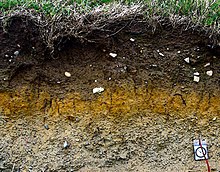Our website is made possible by displaying online advertisements to our visitors.
Please consider supporting us by disabling your ad blocker.
Soil



Soil is loose stuff which lies on top of the land. It has many things in it, like tiny bits of rock, minerals, water and air. Soil also has living things and dead things, called organic matter.
Soil is important for life on Earth because soil holds water and nutrients. It is a very good place for plants to grow. Soil holds the roots, and lets plants stand above the ground to collect the light they need to live. Almost as important are the fungi. There are fungi which grow into plant roots, a symbiosis known as mycorrhiza. This helps trees grow. There are many other fungi that live by breaking down dead organic material: the remains of other living things. The broken down material is a main source of plant nutrients.[1] The soil also has many microorganisms living in it. Many of them eat the organic material in the soil. They use oxygen and release carbon dioxide. They also release mineral nutrients into the soil.[2]
Many animals dig into the soil and make the soil their home. The large animals use soil to make dens for sleeping and giving birth. The small animals live most of their life in the soil. Earthworms are famous for improving soil. This is because the holes they make let air go into the soil. The holes also let water go through.
Soil is different in different places on Earth. This is because the climate and rocks in the Earth are different in different places on Earth. Soils are usually thicker in places where ice sheets covered the land during the Pleistocene ice ages. This is because the ice sheets ground the rock into powder as they slowly moved over the surface.
- ↑ Chesworth, Ward, ed. 2008. Encyclopedia of soil science. Dordrecht, Netherlands: Springer. ISBN 1-4020-3994-8
- ↑ Voroney R.P. 2006. The soil habitat. In Paul, Eldor A. Soil microbiology, ecology and biochemistry. ISBN 0-12-546807-5
Previous Page Next Page


